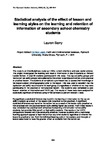Statistical analysis of the effect of lesson and learning styles on the learning and retention of information of secondary school chemistry students
| dc.contributor.author | Barry, L. | |
| dc.date.accessioned | 2019-07-24T11:31:06Z | |
| dc.date.available | 2019-07-24T11:31:06Z | |
| dc.date.issued | 2019 | |
| dc.identifier.citation |
Barry, L. (2019) 'Statistical analysis of the effect of lesson and learning styles on the learning and retention of information of secondary school chemistry students', The Plymouth Student Scientist, 12(1), p. 305-344. | en_US |
| dc.identifier.uri | http://hdl.handle.net/10026.1/14690 | |
| dc.description.abstract |
The study is an interdisciplinary study as it links to both chemistry and also social science. The project investigated the learning and recall of information of year 9 students at Richard Lander School. In total 85 students participated in this study. Two top set ability groups and two bottom set ability groups were selected by the school to participate in either a non-practical or practical lesson. The students all completed a pre-lesson test to assess their knowledge of the lesson subject (chromatography) prior to the lesson. This was used to establish that the top/bottom set ability was the same for each group (1) regardless of whether or not they were participating in the practical or non-practical lesson. The students also completed a post lesson, retention of information and VARK test. The results of these tests were analysed for statistically significant differences using SPSS software to perform relevant t-tests. No significant statistical difference was found in the learning of information for the top set ability students as a result of the lesson style (practical vs non-practical). A significant statistical difference was found for the bottom set as a result of the lesson style (practical vs non-practical) with the practical lesson style yielding higher test scores. From these results it was concluded that practical work enhances the learning of information for low ability students, but provides little benefit for high ability students. The results of the VARK comparisons showed very little conclusive evidence, however students with a multimodal learning approach appear to learn better than any other students regardless of whether the lesson is practical or not. Both the individual learning style of the students and the style of lesson were found to have the greatest effect on students from the bottom set. | en_US |
| dc.language.iso | en | en_US |
| dc.publisher | University of Plymouth | en_US |
| dc.rights | Attribution 3.0 United States | * |
| dc.rights.uri | http://creativecommons.org/licenses/by/3.0/us/ | * |
| dc.subject | retention of information | en_US |
| dc.subject | secondary school chemistry students | en_US |
| dc.subject | Statistical analysis | en_US |
| dc.subject | learning | en_US |
| dc.subject | social science | en_US |
| dc.subject | chromatography | en_US |
| dc.title | Statistical analysis of the effect of lesson and learning styles on the learning and retention of information of secondary school chemistry students | en_US |
| plymouth.issue | 1 | |
| plymouth.volume | 12 | |
| plymouth.journal | The Plymouth Student Scientist |



